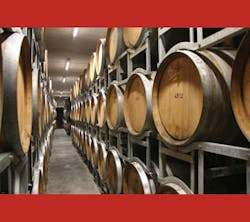Industrial food and beverage is water-intensive—a brewery, for example, typically will use four to seven times the amount of water as the amount of beer it produces. This makes access to clean water critical.
Excess wastewater also must be treated prior to release. This means eliminating biological oxygen demand (BOD), a proxy for dissolved organic molecules. Companies can pay sewer fees for a utility to treat it; however, sewer rates are rising, leading many companies to pretreat BOD prior to release.
Energy intensity is a key cost driver for BOD pretreatment, and existing wastewater treatment technologies already consume a combined 3% of the electricity generated in the U.S. Actually, the dissolved organics that make up BOD contain energy that, with the right technology, can be captured.
High-Rate BOD Removal
There are two major approaches to industrial pretreatment. Aerobic bioreactors consume oxygen together with BOD and, while robust, they require an astounding 1.5 kWh of electricity per kilogram of BOD and generate biosolids that must be disposed at cost. Anaerobic bioreactors leverage methane-generating microbes that degrade BOD without oxygen. They consume less energy and have a lower biosolids yield, but are prone to reactor upsets in the face of fluctuating wastewater volumes and concentrations.
Anaerobic treatment enhanced by bioelectricity can be leveraged by industrial producers. In the late 1990s, scientists discovered naturally occurring bacteria—exoelectrogens—capable of electrical communication with insoluble metals. Exoelectrogens create living electrical catalysts when in contact with electrodes, capable of converting pollutants into electricity and electricity into valuable products like hydrogen or methane.
Since their discovery, exoelectrogens have become widely known. Laboratory-scale devices have been highlighted in many media outlets. More than a widget, the technology can form a new industrial category with impact on the future of water management globally.
EcoVolt uses bioelectricity, and biological anodes convert BOD into electricity and carbon dioxide (CO2). Biologically coated cathodes consume this electricity while converting CO2 into methane. The net reaction treats BOD at a high rate, eliminates a large amount of CO2 from the output and produces high-quality methane fuel.
Bear Republic & Clos du Bois
Since its inception, California’s Bear Republic Brewery has championed sustainability. In addition to a range of operational measures at the facility, the staff recognizes that water management is a critical component of sustainable production. The brewery recently co-invested in new wells with the city of Cloverdale, Calif., to ensure a continuous supply and has reduced its water usage to 3.5 gal of water for every gallon of beer it produces.
In the fall of 2013, Bear Republic became the first major craft brewery to purchase an EcoVolt installation, beginning its application in the brewery industry.
The methane produced by this system is renewable. Using a cogeneration system, Bear Republic expects to generate more than 60 kW of electricity and 25,000 therms per year of heat, cutting operational costs. The system also will cut sewer charges substantially and can form the basis for varying degrees of water reuse—from tank washing to irrigation.
Because it is bioelectric, EcoVolt can be monitored remotely and controlled easily.
For the past 16 months, Clos du Bois, a winery in Geyserville, Calif., has utilized EcoVolt to tap energy using electrically active microbes. At Clos du Bois, the system maintained 80% to 90% treatment through two “crush seasons,” even as wastewater volumes and BOD concentrations changed by more than 75% on a weekly basis. This makes it particularly suited to industrial fluctuations in volume and concentration.
“The unit was commissioned quickly, and it came up to speed and operated better in some areas than competing technology,” said Brian Hemphill, operations manager for Clos du Bois. “This unit can be managed remotely by Cambrian without requiring our time, which makes more sense for us because we’re in the business of making wine—we’re not in the wastewater business.”
Scale & Grow
An EcoVolt system includes at least one headworks unit, modular reactors for treatment and cogeneration systems. The size of a cargo shipping container, reactors are delivered on flatbed trucks, enabling low-cost facility expansion. Bear Republic will be able to treat its current flow and add units as it grows.
“Bear Republic is excited to move forward in playing an active role in the introduction of this new technology,” said Richard “Ricardo” Norgrove, brewmaster and chief operating officer of Bear Republic. “The relationship and friendship we have with Cambrian and the city of Cloverdale will allow us to fulfill a family dream of expanding within Sonoma County, creating a true destination location brewery.”
Download: Here


